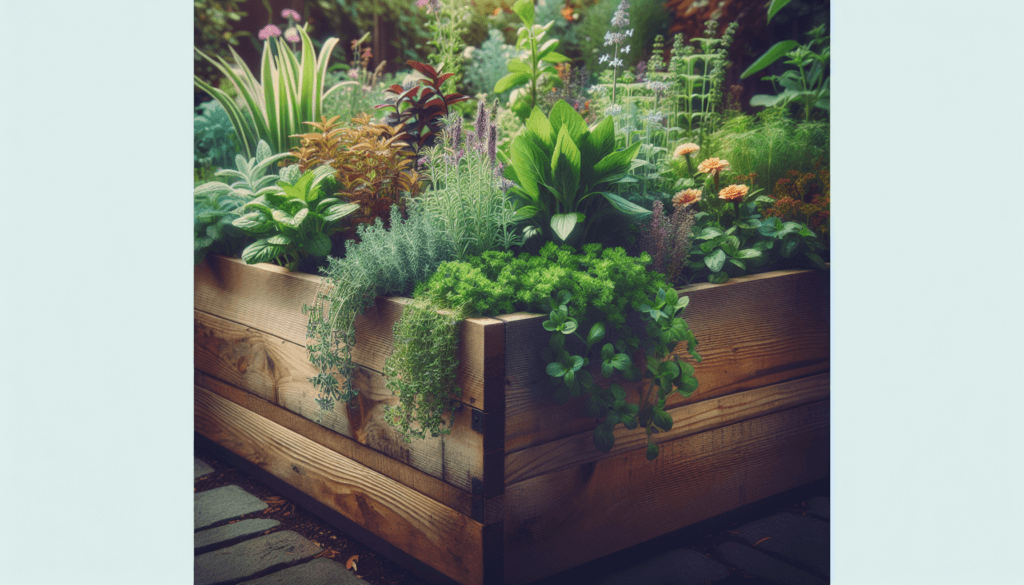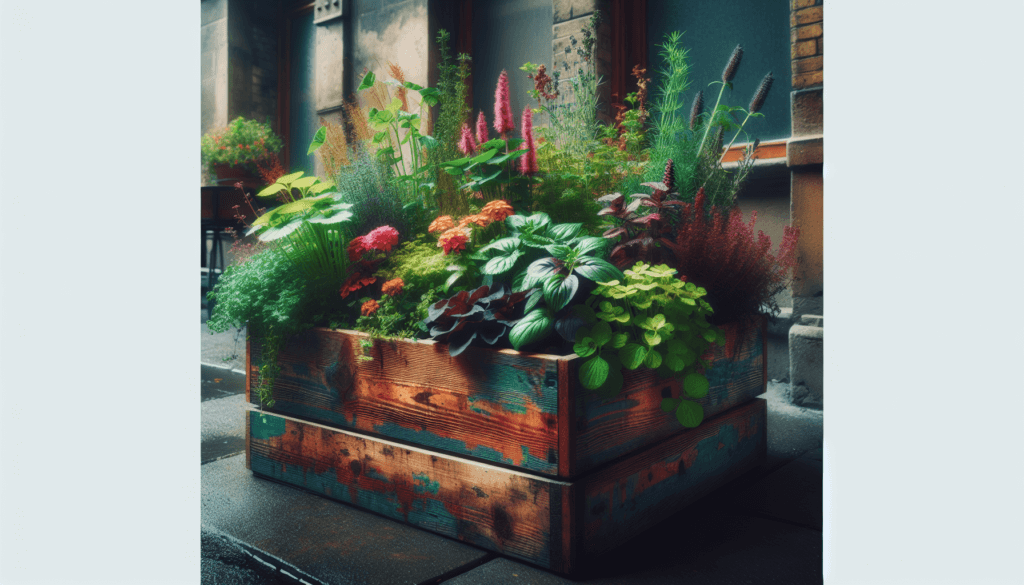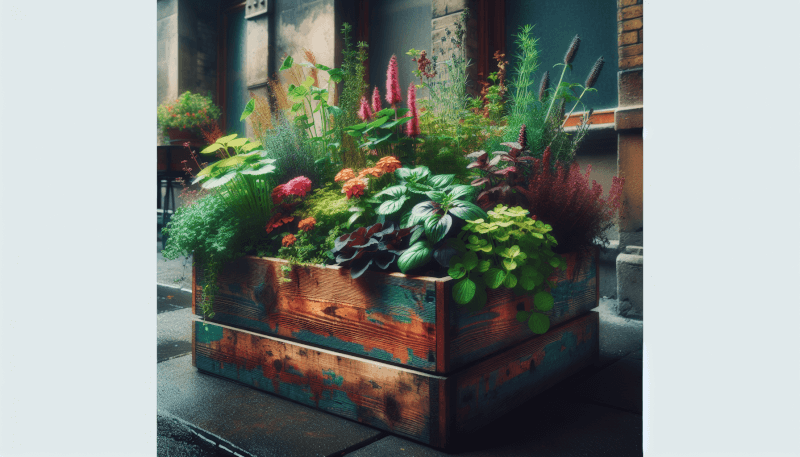Are you a city dweller with a green thumb yearning for a patch of nature to call your own? Look no further! In this article, we will explore the world of DIY raised garden beds specially designed for urban spaces. Discover how to transform even the tiniest balcony or rooftop into a flourishing garden oasis. With simple materials and a touch of creativity, you can bring the joy of gardening into your urban life. Start digging into this guide and unlock the secrets to cultivating your own green paradise.

Benefits of Raised Garden Beds
Maximizing Limited Space
Urban gardening can be a challenge, especially when you have limited space. However, raised garden beds offer a fantastic solution to this problem. By elevating your garden off the ground, you can make the most of your urban space, whether it’s a small backyard, a rooftop, or even a balcony. Raised garden beds utilize vertical gardening techniques and allow you to grow a wide variety of plants without the need for a large plot of land.
Improved Drainage
One of the key advantages of raised garden beds is their excellent drainage. The elevated design prevents water from pooling at the base of the plants, which can lead to root rot and other water-related issues. Instead, excess water can easily drain away, ensuring that your plants receive the right amount of moisture they need to thrive. This improved drainage also helps to prevent soil erosion, keeping your garden beds in top condition.
Enhanced Soil Quality
Another major benefit of raised garden beds is the ability to control and improve the quality of the soil. By using a mixture of high-quality garden soil, compost, and amendments, you can create the perfect growing medium for your plants. This ensures that they have access to the necessary nutrients and minerals, resulting in healthier and more productive plants. Additionally, raised garden beds reduce the risk of soil compaction, as you don’t have to step on the soil while tending to your plants.
Easier Maintenance and Harvesting
Raised garden beds make gardening a breeze, especially when it comes to maintenance and harvesting. The elevated design reduces the strain on your back and knees, making it more comfortable to tend to your plants. Weeding becomes easier as well since raised garden beds provide a clear boundary between your plants and unwanted vegetation. Additionally, with raised beds, you can easily reach every plant without stepping on the soil, minimizing the risk of damaging delicate roots. Harvesting your crops also becomes more accessible, as you can comfortably stand or sit while picking ripe vegetables or fruits.
Protection from Pests and Weeds
Raised garden beds offer a significant advantage in terms of pest and weed control. The elevated design creates a physical barrier that helps keep pests, such as snails and slugs, out of your plants. Additionally, by using a weed barrier underneath the raised garden beds, you can prevent weeds from invading your garden. This reduces the need for labor-intensive weeding and allows your plants to receive all the nutrients and resources they need to grow and flourish.
Choosing the Right Location
Assessing Sunlight Exposure
When selecting the location for your raised garden beds, it’s essential to consider the amount of sunlight the area receives. Most vegetables and herbs require at least six to eight hours of direct sunlight to grow and thrive. Observe your chosen area throughout the day to determine the amount of sunlight it receives. Ideally, choose a location that gets ample sun throughout the day, preferably in the morning and early afternoon.
Considering Accessibility
In addition to sunlight exposure, accessibility is another crucial factor to consider when choosing the location for your raised garden beds. You want to make sure that your garden beds are easily accessible for watering, maintaining, and harvesting your plants. Consider factors such as distance from water sources, proximity to your home, and ease of maneuvering around the garden beds. Having your raised garden beds within reasonable reach will make gardening a more enjoyable and convenient experience.
Considering Drainage
Apart from sunlight and accessibility, drainage is an important consideration when picking the right location for your raised garden beds. Avoid areas prone to flooding or where water tends to accumulate, as this can lead to waterlogged soil and root rot. Ensure that the chosen location has proper drainage to prevent water-related issues and create a healthy environment for your plants to thrive.

Materials and Tools
Wooden Boards
Wooden boards are a popular choice for constructing raised garden beds. They are readily available, easy to work with, and provide a natural aesthetic to your garden. Look for rot-resistant wood such as cedar or redwood, as they are durable and can withstand outdoor conditions for extended periods. Avoid using pressure-treated lumber, as the chemicals used in the treatment can leach into the soil and potentially harm your plants.
Bricks or Cinder Blocks
Bricks or cinder blocks are another option for building raised garden beds. They provide a sturdy and durable structure that can withstand the weight of the soil and the plants. Additionally, bricks and cinder blocks offer a more permanent solution compared to wooden boards, as they do not rot over time. However, keep in mind that they may require more effort and skill to assemble than wooden boards.
PVC Pipes
PVC pipes are a versatile material that can be used to create the frame for raised garden beds. They are lightweight, affordable, and easy to work with. PVC pipes can be cut and joined together to form the desired shape and size of your garden beds. Keep in mind that PVC is not as durable as wood or bricks, so it may not be suitable for long-term use or heavy-duty gardening projects.
Galvanized Steel Sheets
If you’re looking for a durable and long-lasting option, consider using galvanized steel sheets for your raised garden beds. They are resistant to corrosion and can withstand outdoor conditions for years. Galvanized steel sheets can be cut to size and easily assembled to create the frame of your garden beds. However, keep in mind that they may heat up more quickly in direct sunlight, potentially affecting the temperature of the soil.
Screws
Regardless of the material you choose for your raised garden beds, screws are essential for assembly. Make sure to use rust-resistant screws to ensure the longevity of your garden beds. Stainless steel screws are an excellent choice as they are resistant to corrosion and can withstand outdoor conditions.
Hammer
A hammer is a basic tool that you’ll need to secure the components of your raised garden beds together. Choose a hammer with a comfortable grip and a weight that suits your strength and comfort level.
Electric Drill
An electric drill will come in handy when you need to make holes for screws or attach additional elements to your raised garden beds. Look for a drill with different drill bit sizes to accommodate the various screws and fasteners you may need to use.
Measuring Tape
Accurate measurements are crucial when building raised garden beds. A measuring tape will help ensure that your garden beds are the correct size and level. Look for a measuring tape that is easy to use and provides both metric and imperial measurements.
Different Types of Raised Bed Designs
Traditional Rectangular Beds
Traditional rectangular beds are the most common and versatile design for raised garden beds. They are easy to build and provide a large planting area. Traditional rectangular beds are suitable for growing a wide range of crops and can be customized to fit your available space.
Square Foot Gardens
Square foot gardens are a compact and efficient raised bed design that maximizes space utilization. The bed is divided into square sections, allowing you to plant different crops in each square. This design is excellent for small spaces and allows for intensive planting, resulting in a high yield in a limited area.
Tiered Beds
Tiered beds are an excellent option for adding visual interest and maximizing planting space. This design features multiple layers of planting areas, with each layer slightly elevated above the previous one. Tiered beds are suitable for sloped areas or when you want to create a cascading effect of plants.
Vertical Gardens
Vertical gardens are a creative way to maximize space and grow plants upwards. These gardens utilize trellises, hanging baskets, and vertical structures to support climbing plants. Vertical gardens are ideal for areas with limited floor space, such as balconies or walls.
Keyhole Gardens
Keyhole gardens are a unique and efficient design that combines a raised garden bed with a composting system. The raised bed is circular or rectangular with a keyhole-shaped indentation, allowing easy access to add kitchen scraps and water to the center composting area. Keyhole gardens are a sustainable option that promotes recycling and nutrient-rich soil.

Preparing the Ground
Clearing the Area
Before constructing your raised garden beds, you’ll need to clear the area of any existing vegetation, rocks, or debris. Remove any weeds or grass by hand or use a garden hoe or shovel to loosen and remove them. Clearing the area thoroughly will provide a clean slate for your raised garden beds and prevent unwanted plants from competing with your crops.
Tilling the Soil
Once the area is cleared, it’s important to till the soil to break up any compacted layers and improve aeration. Use a garden tiller or a garden fork to loosen the soil to a depth of at least six inches. This will promote root growth and allow your plants to access the nutrients in the soil more easily.
Testing and Amending Soil
After tilling the soil, it’s recommended to test its pH and nutrient levels. Soil testing kits are available at garden centers or can be sent to a laboratory for more detailed analysis. Based on the test results, you may need to amend the soil with organic matter or soil conditioners to create optimal growing conditions for your plants. Adding compost, aged manure, or other organic materials can improve the soil structure and fertility.
Installing Weed Barrier
To prevent weeds from growing up through your raised garden beds, it’s a good idea to install a weed barrier. This can be a layer of landscape fabric, cardboard, or thick layers of newspaper. Place the weed barrier directly on the cleared soil, covering the entire area where your raised garden beds will be placed. Cut holes or slits in the barrier to accommodate the construction of your beds.
Constructing Raised Garden Beds
Measuring and Marking the Layout
Once the ground is prepared, it’s time to measure and mark the layout of your raised garden beds. Use a measuring tape and stakes to determine the desired dimensions and shape of your beds. Mark the corners of each bed with stakes and tie string or twine to create a visual guide for construction.
Cutting and Assembling the Frame
Using the chosen material for your raised garden beds, cut the boards, bricks, or other materials to the appropriate lengths. Assemble the cut pieces into the desired shape, following the measurements and layout you marked earlier. Use screws or other appropriate fasteners to secure the frame together.
Securing the Corners
To ensure the stability and durability of your raised garden beds, it’s important to secure the corners. Depending on the material used, you may need to add additional pieces of wood, metal brackets, or corner braces to reinforce the corners. This will prevent the beds from wobbling or collapsing over time.
Adding Cross Support
For longer raised garden beds, it’s beneficial to add cross supports in the middle of the bed to prevent flexing and sagging. This can be done by installing additional boards or metal braces across the length of the bed, perpendicular to the side panels. These cross supports will distribute the weight and maintain the structural integrity of the bed.
Attaching Bottom Support
If you prefer to have a bottom to your raised garden beds, you can attach a piece of hardware cloth or chicken wire to the underside of the frame. This will provide support for the soil and prevent it from escaping through the bottom. Simply cut the wire to the size of the frame and staple or secure it to the underside.
Optional: Adding Trellis or Supports
If you plan on growing climbing plants, such as tomatoes or beans, consider adding trellises or supports to your raised garden beds. Attach sturdy posts or stakes to the corners or sides of the beds and use twine or wire to create a structure for the plants to climb. This will help maximize vertical space and provide support for your vining crops.

Filling the Beds with Soil
Using Quality Garden Soil
When filling your raised garden beds with soil, it’s important to use a high-quality garden soil. This can be a mix of topsoil, compost, and other organic materials. Avoid using soil from your yard as it may contain weeds, pests, or diseases that can harm your plants. Purchasing a pre-mixed garden soil or consulting with a local garden center can ensure you choose the right soil for your needs.
Mixing in Compost and Amendments
To further enhance the soil quality, consider mixing in compost and amendments. Compost acts as a natural fertilizer and improves the soil structure, drainage, and nutrient content. Add a layer of compost on top of the garden soil and mix it in thoroughly. Depending on the specific needs of your plants, you may also want to add specific amendments, such as lime for acidic soil or sulfur for alkaline soil.
Layering Soil and Organic Matter
For optimal plant growth, it’s beneficial to create layers of soil and organic matter within your raised garden beds. Start by adding a layer of garden soil, followed by a layer of compost or aged manure. Repeat this layering process until the beds are filled, ensuring that the top layer consists of garden soil. This layering technique promotes healthy root development and provides a rich source of nutrients for your plants.
Watering and Settling the Soil
After filling the raised garden beds with soil, water the beds thoroughly to help settle the soil and remove any air pockets. Add more soil if necessary to fill any settling gaps. It’s a good idea to water the beds a few days before planting to allow the soil to settle further. This ensures that the beds are properly filled and ready for planting.
Choosing the Right Plants
Considering Sunlight Requirements
When choosing plants for your raised garden beds, it’s crucial to consider their sunlight requirements. Different plants have different light needs, ranging from full sun to partial shade. Observe the amount of sunlight your chosen location receives throughout the day and select plants that thrive in those conditions. Make sure to group plants with similar sunlight requirements together for optimal growth.
Choosing Suitable Vegetables and Herbs
Raised garden beds offer an excellent opportunity to grow a wide variety of vegetables and herbs. Consider your climate, season, and personal preferences when selecting the plants for your garden beds. Some popular choices for raised beds include tomatoes, peppers, cucumbers, lettuce, herbs like basil and parsley, and root vegetables like carrots and radishes. Choose plants that are well-suited for the available space and take into account their growth habits, spacing requirements, and companion planting possibilities.
Considering Companion Planting
Companion planting is the practice of growing specific plants together for mutual benefits. Certain plants have natural pest repellent properties or improve the growth and flavor of neighboring plants. Take advantage of companion planting by strategically placing plants that benefit each other. For example, planting marigolds near your vegetables can repel pests, while beans can help add nitrogen back into the soil.
Vertical Gardening Options
Raised garden beds also allow for vertical gardening, where plants are trained to grow vertically instead of spreading horizontally. Utilize trellises, stakes, or other structures to support climbing plants such as tomatoes, beans, or cucumbers. This maximizes the use of vertical space, increases airflow around the plants, and makes harvesting easier.

Caring for the Garden Beds
Watering and Irrigation
Proper watering is essential for the health of your raised garden beds. Monitor the moisture level of the soil regularly and water accordingly. As raised beds tend to drain more efficiently, you may need to water more frequently than traditional ground-level gardens. Avoid overwatering, as it can lead to root rot and other water-related issues. Consider using a drip irrigation system or soaker hoses to provide a consistent and efficient water supply to your plants.
Mulching to Retain Moisture
Mulching is a beneficial practice that helps retain moisture in the soil, suppresses weed growth, and regulates soil temperature. Apply a layer of organic mulch, such as straw, wood chips, or shredded leaves, around your plants. This will help keep the soil moist and act as a natural weed barrier. Mulching also improves the overall appearance of your garden beds.
Fertilizing Regularly
To ensure your plants receive the necessary nutrients, it’s important to fertilize your raised garden beds regularly. Opt for organic fertilizers, such as compost or well-balanced organic fertilizers. Apply them according to the package instructions or consult with a local garden center for specific recommendations based on your plants’ needs. Regular fertilization promotes healthy plant growth and improves the overall productivity of your garden beds.
Managing Pest and Disease Control
Raised garden beds offer some natural protection against pests, but it’s still important to monitor and manage any potential pest or disease issues. Inspect your plants regularly for signs of pests, such as chewed leaves or discolored foliage. If necessary, use organic pest control methods, such as handpicking pests, applying neem oil, or using insecticidal soaps. Keep an eye out for common diseases, such as fungal infections or powdery mildew, and take appropriate measures to prevent or treat them.
Pruning and Training Plants
Depending on the types of plants you have in your raised garden beds, pruning and training may be necessary. Pruning involves removing dead or diseased plant parts to promote healthier growth and better airflow. Training, on the other hand, involves guiding the growth of climbing or vining plants using supports or trellises. Regularly prune and train your plants to maintain their shape, improve productivity, and prevent overcrowding.
Conclusion
Raised garden beds offer numerous benefits for urban gardeners. From maximizing limited space to improving drainage and soil quality, they provide an excellent solution for growing plants in urban environments. By choosing the right location, materials, and designs, constructing raised garden beds becomes a rewarding and manageable DIY project. Once your raised garden beds are in place, proper soil preparation, plant selection, and regular care will ensure a flourishing and productive garden. So get started on your own raised garden beds and enjoy the abundance of fresh homegrown vegetables, herbs, and flowers that await you!


